Saturday, November 06, 2004
Billon antoninianus, Gallienus, Mediolanum, Göbl 1002r
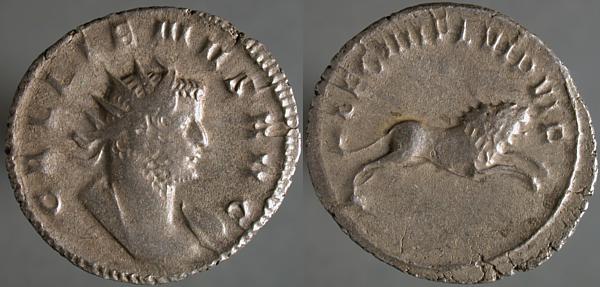
GALLIENVS AVG, Radiate cuirassed bust right, both ribbons behind | LEG IIII FL VI P VI F, Lion springing right.
Another of the legionary series, this honoring Legio IIII Flavia Felix, raised by Vespasian from the remnants of Legio IIII Macedonica.
We think of the lion as an animal of the African grasslands, but it was present throughout Europe and Asia Minor until it was exterminated there. The realistic portrayals of the animal on the coinage of the time clearly originated from personal observations.
Friday, November 05, 2004
Æ31, Syedra in Cilicia, Gallienus, SNG Levante 439 (this coin)
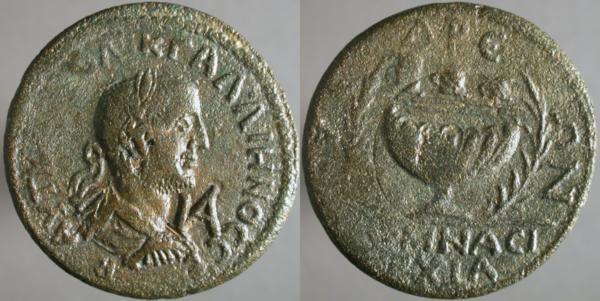
ΑYΤ ΚΑ[Ι Π]Ο ΛΙΚ ΓΑΛΛΙΗΝΟC C_Ε_Β, Laureate draped bust right | CΥΕ_ΔΡΕ_ΩΝ, Water basin, three one-handled vases above, palms to either side. ΓΥΜΝΑCΙ / ΑΡΧΙΑ in two lines in exergue.
Another example of a coin that celebrates (or advertises) an athletic competition. The ΓΥΜΝΑCΙΑΡΧΙΑ was the magistrate in charge of this competition, probably being responsible particularly for paying for it.
Thursday, November 04, 2004
"a method that's a little different than the standard"
"starch, powdered tin oxide and animal fat"
Billon antoninianus, Salonina, Köln, Göbl 902c
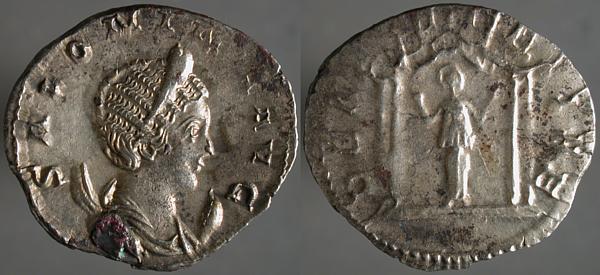
SALONINA AVG, Diademed draped bust right on crescent | DEAE SEGETIAE, Tetrastyle temple, nimbate statue of Segetiae within, with both hands raised.
The companion to the Gallienus DEO MARTI and Valerian DEO VOLKANO coins I posted over the last few days. This coin features the infrequently-seen goddess Segetia, who protected seeds in the ground.
Wednesday, November 03, 2004
AR denarius, Roman Republic, 108/107 BCE, brockage of RSC Valeria 11

Winged and draped bust of Victory right, XVI monogram beneath chin | brockage.
Back in January I posted an example of a brockage from just a year or two before this. Here's another example of a coin where the reverse is an impression of another coin stuck to the die, rather than the die itself.
It's just a coincidence that the two examples I've posted have been from the Roman republic, brockages like this happened frequently in any operation that produced coins by hand.
Tuesday, November 02, 2004
Æ20, Samos (Ionian Island), Gallienus, SNG Copenhagen 1811
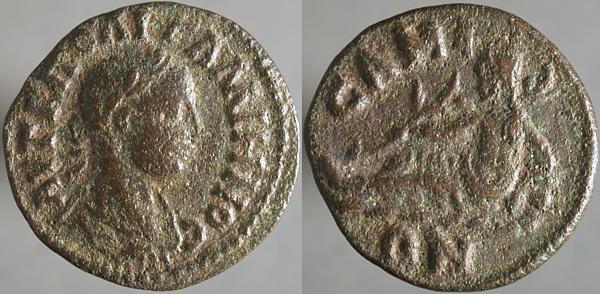
ΑVΤ Κ ΠΟ ΛΙ ΓΑΛΛΙΗΝΟC, Laureate draped bust right | CΑΜΙ_ΩΝ, River god Imbrasos reclining, holding reed left.
It's often frustrating to consider how much we don't know about the ancient world, and about the Roman economy. Most of the provincial coins of this time are large, but there are some small ones, like this 20mm piece and the even smaller Æ15 from Ephesus I posted some time ago.
We know that the imperial "silver" coinage had become bronze with a silvered exterior, that the imperial bronze had all but disappeared, and that there were few provincial coins minted after this reign, except for Egypt. All of this suggests that there must have been serious inflation, but we don't have good evidence for it.
In any case, somebody felt the need for small coins, at least in Ionia.
Monday, November 01, 2004
Off-topic
Billon antoninianus, Valerian, Köln, Göbl 884d
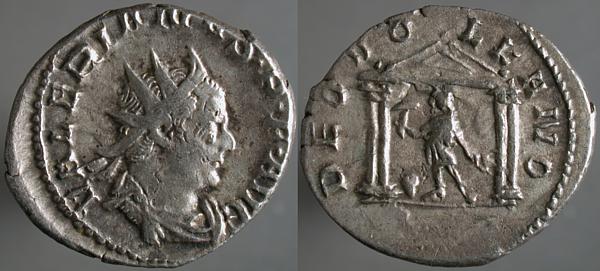
VALERIANVS·P·F·AVG, Radiate draped cuirassed bust right | DEO VOLKANO, Tetrastyle temple with statue of Vulcan within, holding hammer left and tongs? right, anvil at feet left.
A companion to the Gallienus coin I posted Saturday, this coin of his father features Vulcan, the blacksmith of the gods.
Sunday, October 31, 2004
Æ21, Alexandria Troas, Salonina, BMC 189
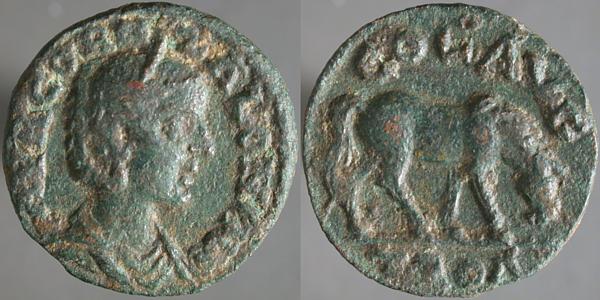
[AV]R CORN SALONINA (retrograde S in SALONINA), Diademed draped bust right | COL AVG TROA, Horse grazing right.
The most frequently seen reverse for Alexandria Troas, used for centuries, here on a coin minted in the name of Salonina.

